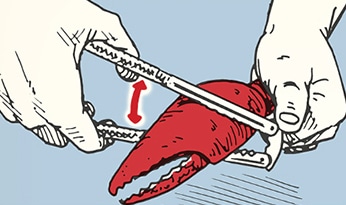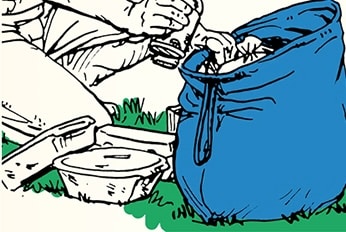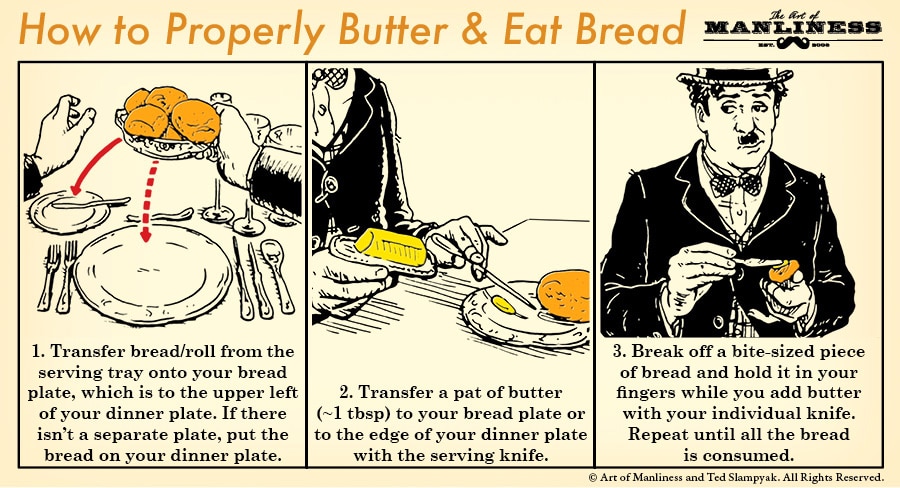
Editor’s note: This is a guest post from Justin Fauci of Lean Muscle Project.
When you hear the word “diet” what’s the first thing that comes to mind?
If you’re like most men, you probably think about tiny portions of bland, boring diet foods. A small chicken breast with some steamed broccoli. Plain oatmeal. Cottage cheese. And, of course, salad. Lots and lots of salad.
Or perhaps you thought about one of the many trendy diets that have succeeded in grabbing the public’s attention over the years: Atkins, The Zone, South Beach, or Paleo. It’s likely that you’ve even tried one of these diets in the past.
“Don’t eat carbs, they make you fat!” exclaim the Atkins devotees and other low-carb zealots.
“Cavemen didn’t eat bread or cheese – so neither should you!” shout the Paleo experts, while stirring sticks of butter into their morning coffees. Yes, that’s a thing now.
You see, this is the common element among nearly all of these fashionable diets: food exclusion. You invariably have to stop eating certain types of food that you really enjoy.
To get around this, some diets have incorporated “cheat days” where you get to eat whatever you want on one day of the week. But the innocent idea of a cheat day often leads to dieting disaster. People use these days as an excuse to cram in as much junk food as they possibly can. After all, “It’s part of the diet.” I’ve even known people to literally set their alarms to 12:00 a.m. so they can start cheating the very first minute of the day. Clearly, this is a recipe for failure.
But we’re men. We love to eat, and specifically, we love to eat man food. Stuff like bacon, pizza, guacamole, and steak sandwiches. And telling us that we can’t eat our favorite foods is only going to lead to short-term success at best. If we can’t find a way to incorporate a dieting strategy that works, then the unfortunate truth is that sooner or later, we’re going to fail.
Now for the good news. You don’t actually have to give up any of your favorite foods in order to lose weight. Not a single one.
Don’t believe me? Here’s a short list of just a few foods that I ate during a recent cutting phase where I lost 10 pounds and reached 7% body fat:
- chicken with pasta and Italian bread
- chicken pad thai
- a whole Domino’s cheese pizza
- beef burrito with a side of chips and guacamole
- cheeseburger and fries
- ice cream, Oreos, Nutella, Pop Tarts, and other sweets
Now you really don’t believe me. But that’s okay, because I’m going to prove it to you, and in the process, show you exactly how you can lose as much weight as you want while eating the foods you enjoy the most.
The Weight Loss Secret Worth Billions Of Dollars
I’m about to reveal to you one of the most highly guarded secrets in the weight loss industry. It’s mind-blowingly simple, yet if it were known and fully accepted by the general population, the weight loss industry would literally lose billions of dollars of revenue each year.
Are you sitting down?
The secret is this: in order to lose weight, you have to eat fewer calories than your body burns, on a regular basis.
Hmmm. Doesn’t sound like much of a secret, does it? Even though it’s been proven again and again and again, the reality is, most people haven’t really accepted this simple truth as scientific fact.
How else do you explain the multi-billion dollar weight loss industry, filled to the brim with diet books, gurus, surgeries, pills, and potions?
Mark Haub, a professor of human nutrition at Kansas State University, set out to prove that successfully losing weight is only about energy balance – consume fewer calories than you burn, and you’ll lose weight. He went on a “convenience store diet,” eating primarily junk food: Twinkies, Hostess cupcakes, Doritos, cereal, and Oreos. But he limited his intake of these foods to less than 1,800 calories per day.
The results? He lost 27 pounds in 2 months. Not too shabby.
Now before you suddenly stop reading this article and race off to the nearest convenience store to start your own Twinkie diet, let me first point out that this is not what I’m recommending to you. It’s just an extreme example to show you that weight loss is purely a function of caloric intake.
What I am going to show you, though, is how to use this principle to go on a healthy diet that doesn’t exclude any of your favorite foods, and how a flexible diet like this can offer tremendous psychological advantages in terms of long-term success.
Introduction to Flexible Dieting/IIFYM
Flexible dieting is simply a way of dieting that emphasizes calorie intake and macronutrient composition over food choices. In the world of bodybuilding, flexible dieting is more commonly known as IIFYM – If It Fits Your Macros. Although this concept has been around for decades, it has only recently exploded in popularity.
The basic premise is this: You determine approximately how many calories you should be consuming in order to lose weight. Then you figure out your macronutrient targets – that is, how many grams of protein, carbohydrates, and fat you’re aiming for on any given day. (Don’t worry, I’ll show you how to do this later.) You eat a diet composed of whatever foods bring you to those numbers – hence the name, If It Fits Your Macros.
Does three slices of pizza fit your macros? Then it’s okay to eat. The same goes for burgers, french fries, bread, pasta, tacos, chips, chocolate, etc. No food is off limits.
As long as you’re consuming fewer calories than your body burns, you’ll lose weight.
What About “Clean Eating”?
This is where most people grab their pitchforks and start ranting and raving about how important it is to “eat clean.” But of course, everybody has their own definition of what “clean eating” actually is, don’t they?
The paleo crowd would argue that clean eating is consuming only the foods that our human ancestors would have consumed during the Paleolithic era, which means no grains, no dairy, and no processed foods. Paleo followers eat mostly meat, vegetables, fruits, nuts, and seeds.
Meanwhile, vegetarians and vegans look at the meat-eating paleo crowd with horror, shocked at how civilized human beings can poison their bodies with the “unnatural” consumption of meat.
Let’s not forget about the low-carbers who demonize any diet with a relatively high level of carbohydrate intake, blaming carbs for everything from insidious weight gain to heart disease and diabetes. And we’re not even going to talk about the recent gluten-free craze that’s taking over, despite most people having absolutely no idea what gluten actually is.
The point is that how you define “clean eating” depends on who you ask – there’s no universally accepted standard.
The 80/20 Rule
No matter what set of dietary principles you choose to follow, I believe that it’s important to allow yourself to consume the foods you love, on a regular basis, in order to succeed with your weight loss goals.
This isn’t to say, though, that you should only eat nutritionally-deficient junk food. For optimal health and the prevention of disease, it’s important to eat a diet that’s rich in vitamins, minerals, antioxidants, and phytonutrients.
The best way to maintain a balanced approach to your diet is to follow the 80/20 rule. A minimum of 80% of your diet should be composed of nutritious whole foods, and a maximum of 20% of your diet should be the other stuff. This rule gives you plenty of room to enjoy all types of foods, without labeling any particular food as good or bad. They all have a place somewhere in your diet.
The 80/20 rule allows you to enjoy a good deal of flexibility with your diet and offers significant psychological advantages over rigid diets with strict rules. In fact, in a study conducted on rigid vs. flexible dieting, there was a strong correlation between flexible dieting and lower body weight, lower levels of depression and anxiety, and an absence of overeating.
I’ve personally experienced the negative psychological effects of rigid food restriction. In the past, whenever I wanted to lose some body fat, I’d start eating less and restricting certain foods entirely. For example, I never allowed myself to eat any sort of dessert or snack food – not even a single cookie. But after perhaps a week or two of dietary compliance, I just couldn’t resist having a little bit of ice cream or chocolate. The problem was that “a little bit” quickly turned into an all-out binge. Because I had already broken the rules, I figured I might as well make the most of it and eat as much as I wanted, of whatever I wanted. The diet was over, and it would be days, if not weeks, before I mustered up enough conviction to start a new challenge of dietary perfection.
This type of all-or-nothing dieting is extremely common, and from my experience, it is the single biggest reason that most people have difficulty losing weight and keeping it off. Understanding the principles behind flexible dieting will help you avoid this massive pitfall. Because no food is considered “bad,” you can make literally any food fit into your diet. Eating a single cookie no longer means that you’ve failed. Instead, you could theoretically eat several cookies every day, as long as they fit into your 20% maximum.
How To Get Started With Flexible Dieting
I’m going to outline exactly how you can start losing weight with flexible dieting, and I’m going to make it as simple as possible. If you follow my instructions, I promise you that you will lose weight without having to ban a single food that you love.
Step 1 – Calculate Your Calories
The first thing you need to do is figure out how many calories you should consume on a daily basis in order to put your body into a caloric deficit. This means that you will be consuming fewer calories than your body burns, and you’ll start losing weight.
There are several fancy calculators and formulas online that will figure out a number for you based on age, height, activity level, job, etc. But all of these calculations are just estimates, and inevitably you’ll have to make adjustments based on your individual needs.
So I start with a simple approach: multiply your body weight by 12.
If you currently weigh 200 pounds, then you should eat 2400 calories per day (200 x 12) to start losing weight. That’s all there is to it.
Step 2 – Calculate Your Macronutrients
There are 3 primary macronutrients: protein, fat, and carbohydrate. A gram of protein has 4 calories, a gram of carbohydrate has 4 calories, and a gram of fat has 9 calories.
I didn’t talk much about macronutrients in this article because I wanted to focus on the fact that weight loss is determined primarily by caloric intake. In fact, you could lose as much weight as you want without even thinking about macronutrients (recall the Twinkie diet).
But I’m guessing that even if you’re not interested in building muscle, you at least want to preserve the muscle mass you do have. To do that, you have to make sure that you’re taking in an adequate amount of protein. While protein is always an essential component of human nutrition, it becomes even more important when you’re dieting.
Again, I like to keep things as simple as possible, so here are my recommendations:
- Eat 1 gram of protein per pound of body weight.
- Eat 0.4 grams of fat per pound of body weight.
- Eat 1.1 grams of carbohydrates per pound of body weight.
So for a 200-pound guy, the macronutrient targets would be 200 grams of protein (200 x 1), 80 grams of fat (200 x 0.4), and 220 grams of carbohydrates (200 x 1.1).
Step 3 – Start Logging Your Food Intake
Yes, I am going to ask you to count calories. But don’t worry, I’m not going to ask you to do it forever.
The reason I’m asking you to log your calories is because quite frankly, there is no other way to know how many calories you’re consuming. You may think you have an idea, but once you actually start to log it, you’ll be in for a big surprise. Most people underestimate their caloric intake by a large degree.
These days, keeping track of your calories is easier than ever with great apps like MyFitnessPal and FatSecret. Just use one of these apps and attempt to hit your calorie and macronutrient goals, using whatever foods you like.
For weight loss, the most important number to hit regularly is your calorie target — and try to stay within 50 calories of this number each day.
Similarly, you should apply the same type of flexibility to your macronutrient targets. If your protein target is 200 grams, for example, it really doesn’t matter if you get 190 or 210 grams. Just attempt to be within the ballpark for these numbers.
You don’t have to log your food intake forever. A lot of guys eat the same foods on a regular basis, and once you dial in your diet so that you’re routinely hitting your nutrition targets, you can stop logging your food.
Step 4 – Make Adjustments As Necessary
Weigh yourself on the same day of the week, every week, after you wake up and go to the bathroom, and before you eat or drink anything.
If after 2 weeks you’re not losing any weight, then decrease your calorie levels by 10%. So if you were consuming 2400 calories daily, lower that number to 2160. The goal is to lose 1-2 pounds per week.
Additional Suggestions
Let me wrap this up by leaving you with a few suggestions and tips that I think will be helpful:
- Beware hidden calories. These are the calories that come from sources you may not consider counting, such as the olive oil you use to cook your chicken or the mayonnaise in your potato salad.
- Eat 1-2 pieces of fruit per day and at least 1 serving of vegetables with each meal. This will help to make sure you’re getting adequate nutrition.
- Feel free to drink alcohol, but be sure to log the calories from alcohol as part of your food intake. Decrease the amount of fats and/or carbs you consume on days you drink to compensate for the alcohol calories. Learning the calories in various beers and mixed drinks will help you make more informed decisions when you’re out drinking.
- Don’t worry about meal timing. Eat when you want to, whether that’s 2 meals per day or 6. In fact, you may want to try combining flexible dieting with intermittent fasting. Intermittent fasting allows you to eat huge meals, and this is exactly how I managed to eat a full pizza one day and still not break my diet.
I strongly encourage you to give flexible dieting a try so you can see for yourself how freeing it is to lose weight without giving up any of your favorite foods. To me, eating great food is one of the most pleasurable experiences in life, and flexible dieting gives me the freedom to enjoy all the foods I love without any of the guilt.
Listen to our podcast on how to lose weight, and keep it off forever:







